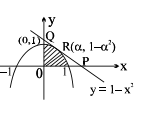Q. If the tangent to the curve $y =1- x ^2$ at $x =\alpha$, where $0< \alpha< 1$, meets the axes at P and Q. Also $\alpha$ varies, the minimum value of the area of the triangle $O P Q$ is $k$ times the area bounded by the axes and the part of the curve for which $0< x <1$, then $k$ is equal to
Application of Integrals
Solution:
